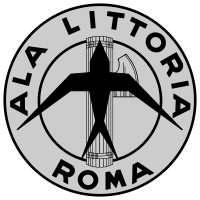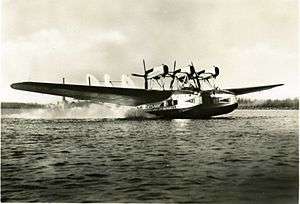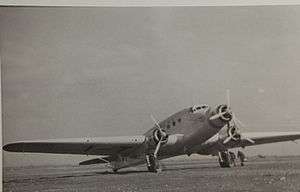Ala Littoria
 | |
| Founded | 1934 |
|---|---|
| Ceased operations | 1945 |
| Parent company | Italian government |
| Headquarters | Italy |
Ala Littoria was the Italian national airline that operated during the fascist regime in the 1930s and 1940s.[1]
History
Ala Littoria was formed by a merger of Società Aerea Mediterranea (SAM), Società Anonima Navigazione Aerea (SANA), Società Italiana Servizi Aerei (SISA) and Aero Espresso Italiana (AEI) in 1934.
The airline was owned by the Italian government and predominantly featured the Italian flag on its aircraft. It also showed the fascism symbol in some routes.
The airline used mainly state-of-the-art aircraft from Savoia-Marchetti, but other Italian aircraft (like "Breda" and "Caproni") were used in the late 1930s.
The first commercial flight in Italy was started in 1923,[2] but it reached full international service only with "Ala Littoria" that was promoted by Mussolini with a name related to the "Fasci Littori" of his Fascism.
Like many other European nations did in their early phases of civil aviation, Italy initially formed several small companies that struggled to provide a modest level of passenger service. The first of these was the Aero Expresso Italiana (AEI), founded on December 12, 1923, which began offering services in August 1926. By 1930, there were five other Italian airlines, including the Società Italiana Servizi Aerei (SISA), the Società Area Navigazione Aerea (SANA), the Società Area Mediterranea (SAM), and the Società Area Avio-Linee Italiane (ALI). Almost all of these early Italian air services were state-owned or state supported. The only major exception was the ALI, which was backed by the powerful Fiat industrial empire, a builder of automobiles. The three biggest airlines, SISA, SANA, and SAM, equally split the Italian civil aviation market, carrying about 10,000 passengers per year by 1930. If in 1925, it seemed like Italians hardly had a civil aviation sector, by 1930, they had made rapid progress (when "Ala Littoria" was created). In fact, Italian commercial aviation in 1930 was third in terms of the number of passengers carried, after Germany and France, and ahead of Great Britain and the Netherlands.[3]
In 1934 Ala Littoria was enlarged and started some flights toward European countries, like France, and also toward the eastern Mediterranean region[4]
After the Spanish Civil War, Ala Littoria invested in Iberia, the Spanish airline that was established following the demise of LAPE. Ala Littoria acquired 12,5 % of the airline and purchased three Junkers Ju 52 airframes without engines from Lufthansa, giving them to Iberia in lieu of capital.[5]
| Linea dell'Impero aircraft | |
|---|---|
 | |
| Savoia-Marchetti SM.75 "Marsupiale" of Ala Littoria |
Ala Littoria flew to destinations across Europe and the Italian colonies in Africa. In 1934 was done an experimental flight from Rome to Mogadiscio in Italian Somalia,[6] that established a world record on long distance civil flight and allowed to start the prestigious Linea dell'Impero the next year, in 1935.
The Imperial Line was the longest route in Africa by Ala Littoria in the years preceding World War II and was considered the most prestigious Italian air route of the time.[7] It connected Rome with Mogadiscio in Italian East Africa, and from 1939 the route could be travelled without a change of airplane[8] with a state-of-the-art- Savoia Marchetti (civilian) SM 75.[9]
In March 1938 the airline did the first record flight from Rome to Argentina with the route Roma-Cagliari-Bathurst/Gambia-Bahia-Rio de Janeiro-Buenos Aires, using a special hydroplane of the model Cant Z 506,[10] but later the company was substituted by the newly created LATI for the Latin American flights.
Ala Littoria routes in 1940 grew to 37,110 km, mainly in the Mediterranean and Africa. This accomplishment made the airline the fifth in the world (after the USA, URSS, Germany and UK's national airlines).
During the Second World War, Ala Littoria acted as a transport service for the Italian military. However the airline did not survive the war and was disbanded. It was substituted after the war by Alitalia – Linee Aeree Italiane, that was established on 16 September 1946 as "Aerolinee Italiane Internazionali" and later was called Alitalia.
Airports connected
In 1940 Ala Littoria reached and connected the following airports:
Italy
- Alghero, Ancona, Bologna, Brindisi, Cagliari, Catania, Fiume, Genoa, Lussino (at that time Italian territory), Milan, Naples, Palermo, Pola, Rimini, Rhodes, Rome, Syracuse, Trapani, Trieste, Venice, Zara.
Northern and Eastern Italian Africa
- Addis Ababa, Asmara, Massaua, Assab, Dessiè, Dire Dawa, Gambela-Dembidollo, Gimma, Gondar, Gorrahei, Lechemtì-Asosa, Mogadishu, Negelle, Benghazi, Tripoli.
Europe
- Athens, Barcelona, Belgrade, Berlin, Bucharest, Cadiz, Constanța, Lisbon, Malaga, Malta, Marseille, Munich, Palma, Paris, Thessaloniki, Seville, Tirana, Vienna.
Middle East and Africa
- Baghdad, Basra, Cairo, Djibouti, Haifa, Khartoum, Melilla, Tetouan, Tunis, Wadi Halfa.
Airplanes
In 1940, Ala Littoria's fleet included 39 Seaplanes and 74 landplanes:


Airplanes
Accidents and incidents
Only 3 accidents happened to Ala Littoria, that was considered one of the safest world airlines in the late 1930s:
- On 2 August 1937 a Savoia-Marchetti S.73 of Ala Littoria crashed on approach to Wadi Halfa Airport (WHF/HSSW), Sudan, with the loss of all 9 occupants (6 pax and 3 crew).[11]
- On 30 April 1938 a Savoia-Marchetti S.73 of Ala Littoria crashed on a flight from Tirana to Rome. The aircraft struck the mountains near Maranola and all nineteen occupants were killed.[12][13]
- On 4 December 1939, an Ala Littoria Junkers Ju 52/3mlu flying in bad weather between Munich and Berlin struck a hillside near Bayerisch Eisenstein, Germany, at an altitude of about 1000 meters (3281 feet) and crashed, killing four of the 17 people on board.[14]
See also
References
- ↑ Caprotti F (2011) 'Profitability, practicality and ideology: Fascist civil aviation and the short life of Ala Littoria, 1934-1943.' The Journal of Transport History, 32(1), pp.17-38.
- ↑ The birth of air transport
- ↑ Century of flight: Italian civil service
- ↑ Timetable of flights to France and other countries
- ↑ Berlin-Spotter - Iberia (in German)
- ↑ Original article on the Rome-Mogadiscio flight (click to enlarge)
- ↑ Rosselli: The air links between Italy and Italian Africa
- ↑ Ala Littoria timetable March 28, 1938 ("Linea dell'Impero")
- ↑ Savoia Marchetti SM 75, civilian version
- ↑ Ala Littoria, 1934-1941 (in Italian)
- ↑ Aviation Safety Network: Accident Description
- ↑ "The Italian Disaster", Flight, p. 442, 5 May 1938, retrieved 3 May 2011
- ↑ http://www.flightglobal.com/pdfarchive/view/1938/1938%20-%201258.html?search=the Italian disaster
- ↑ Aviation Safety Network: Accident Description — error in this database record: either departure/destination airports are swapped (Berlin vs Munich), or the accident occurred at the first leg (after takeoff) and not at the final leg of the route, as this record at "Aviation Safety Network" indicates now.
External links
| Wikimedia Commons has media related to Ala Littoria. |